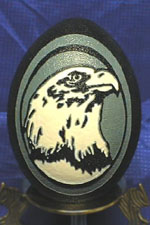Engraving Emu Eggsby Gary LeMasterreprinted with permission from
|
Emu eggs offer an endless number of options due to the colored layers you reveal as you carve. Add to that a few elements that are carved through the entire shell and the design possibilities are almost mind-boggling. This is a simple over view of carving emu eggs.
 Since you have three shades of color to work with, it is best to choose patterns and images that display a high degree of contrast. that is, they have dark shades, light shades and some in-between hues as well. The eagle pictured here is a good example. Once my image is drawn on the eggshell, I use the 33 1/2 inverted cone bit to place initial cuts around every single element of the design. Then, since the cone has given me such clean lines to work with, I return with the diamond football bit and start eliminating layers. Once you have a hint of the white layer peeking through (should you choose to go that deep) you need to use a far less aggressive bur as the white layer is usually paper thin. Hence the value of the abrasive stone bits. I use the green stone bur to pretty much even everything out, then do final smoothing with the white stone. If you've decided to utilize the white layer, I'd suggest that you try in very small areas at first, until you really have a good feel for just how light your touch needs to be. This is not to imply that beautiful pieces cannot be created without the white layer. On the contrary, a sense of elegance can very easily be found in two-color schemes. As an example, look at this photo of my youngest son. Then check out the emu egg to the right.
The egg rendition is not yet complete, but I wanted to quickly get a good enough example to include here as an illustration. I can already hear several of you saying that there's no way you can do this because you aren't an artist. Well, listen up and we'll just see. If you are adept at rendering, you know that all this requires is to eyeball the subject and pick a medium shade. Everything darker than that shade becomes black. Everything lighter becomes white. But what can you do if you can't draw worth a darn? Well, there are options. For one thing, you can learn this technique by tracing photos and images onto tracing paper and practicing a whole bunch. Believe it or not, you can get some pretty good results with this method, especially if you work from a Xeroxed copy of the photo rather than the photo itself.  However, if you have a computer and some graphics software, the solution may just be at hand. I know that many of you have scanners and they usually come with graphics software. If not, there are tons of shareware programs available for download from the Net. I really enjoy working with Paint Shop Pro which is available from the authors at http://www.jasc.com/. Another great shareware program, especially for the technique we are about to discuss, is Thumbs Plus! available for download at http://www.cerious.com/ . A wide variety of graphics software (as well as just about any other software you could ever want) is also available at http://www.tucows.com/ . Alright, let's assume that you have your graphics software installed and you have a picture to work with in the computer. Almost every graphics package I've ever seen has a way to reduce your photo to two colors. That's what you need to do. the command is usually found under the "color" menu, but in some programs it might be located in the "effects" menu. You'll just have to experiment. I remember that in Microsoft's Photo Editor it is called "stamp". The bottom line is that you have to get the photo reduced to two colors, not just to a Grey scale format. The reason that I like how Thumbs Plus! handles this is because it includes settings to determine the exact density and relationship you want with the two colors. Oftentimes, it is helpful to soften or blur the image before doing the color reduction, as this helps prevent the jagged edges associated with computer graphics. This technique requires a great deal of experimentation, but is well worth the effort. |
 |
 |
Gary LeMaster is the publisher of
The Eggshell Sculptor
Subscription to this magazine is $30.00 U.S.
Gary LeMaster
The Eggshell Sculptor
415 Terrace Road
Iowa City, IA 52245
Ph. 319-338-2094
Fax 319-339-9133
EggZotic@aol.com
http://www.eggzotica.com/
Copyrightę1997

